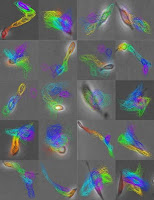New method decodes cell movements, accurately predicts how cells will divide
Monday, 01 March 2010
Researchers at Rensselaer Polytechnic Institute have discovered a new method for predicting – with up to 99 percent accuracy – the fate of stem cells.
Using advanced computer vision technology to detect subtle cell movements that are impossible to discern with the human eye, Professor Badri Roysam and his former student Andrew Cohen can successfully forecast how a stem cell will split and what key characteristics the daughter cells will exhibit.
By allowing the isolation of cells with specific capabilities, this discovery could one day lead to effective methods for growing stem cells on a large scale for therapeutic use.
 "If you have many cells in a culture, they all look the same. But our new method senses all sorts of tiny differences in the shapes and movements of the cells, and uses these cues to predict what kind of cells it will divide into," said Roysam, professor of electrical, computer, and systems engineering at Rensselaer.
"We believe this method will be beneficial for one day taking cells from a patient, and then growing large amounts of the kind of cells that patient is in need of. This could enable many new and exciting types of medical treatments using stem cells."
Results of the study, titled "Computational prediction of neural progenitor cell fates," were published recently in the journal Nature Methods.
In order to achieve successful stem cell-based therapies, researchers require access to large amounts of specific cells. This has proven difficult, as there are currently no methods for controlling or manipulating the division of bulk quantities of cells. When stem cells or progenitor cells divide via mitosis, the resulting daughter cells can be self-renewing or terminal. A self-renewing cell will go on to split into two daughter cells, while a terminally differentiated cell is fated to be a specific, specialized cell type. Researchers want the ability to influence this division in order to produce large volumes of the correct type of cells.
Roysam and Cohen tracked the development of rat retinal progenitor cells cultured in their collaborator's laboratory at McGill University. The computer system they developed took images of the cells every five minutes, and employed algorithmic information theoretic prediction (AITP) to observe the behaviour of the cells, analyze the behaviour, and discern whether each individual cell is fated to split into self-replicating or terminal daughter cells. This process occurs in real time, so researchers know the fate of cells before they actually divide.
"If you have many cells in a culture, they all look the same. But our new method senses all sorts of tiny differences in the shapes and movements of the cells, and uses these cues to predict what kind of cells it will divide into," said Roysam, professor of electrical, computer, and systems engineering at Rensselaer.
"We believe this method will be beneficial for one day taking cells from a patient, and then growing large amounts of the kind of cells that patient is in need of. This could enable many new and exciting types of medical treatments using stem cells."
Results of the study, titled "Computational prediction of neural progenitor cell fates," were published recently in the journal Nature Methods.
In order to achieve successful stem cell-based therapies, researchers require access to large amounts of specific cells. This has proven difficult, as there are currently no methods for controlling or manipulating the division of bulk quantities of cells. When stem cells or progenitor cells divide via mitosis, the resulting daughter cells can be self-renewing or terminal. A self-renewing cell will go on to split into two daughter cells, while a terminally differentiated cell is fated to be a specific, specialized cell type. Researchers want the ability to influence this division in order to produce large volumes of the correct type of cells.
Roysam and Cohen tracked the development of rat retinal progenitor cells cultured in their collaborator's laboratory at McGill University. The computer system they developed took images of the cells every five minutes, and employed algorithmic information theoretic prediction (AITP) to observe the behaviour of the cells, analyze the behaviour, and discern whether each individual cell is fated to split into self-replicating or terminal daughter cells. This process occurs in real time, so researchers know the fate of cells before they actually divide.
 The researchers predicted with 99 percent accuracy if the rat retinal progenitor cells would split into self-renewing or specialized cells, and predicted with 87 percent accuracy certain characteristics of the specialized cells.
"Our results suggest that stem cells display subtle dynamic patterns that can be sensed computationally to predict the outcome of their next division using AITP," Roysam said.
"In theory, AITP can be used to analyze nearly any type of cell, and could lead to advances in many different fields."
Roysam said prototyping and development of the system leveraged the processing power of Rensselaer's supercomputer, the Computational Center for Nanotechnology Innovations (CCNI).
.........
ZenMaster
The researchers predicted with 99 percent accuracy if the rat retinal progenitor cells would split into self-renewing or specialized cells, and predicted with 87 percent accuracy certain characteristics of the specialized cells.
"Our results suggest that stem cells display subtle dynamic patterns that can be sensed computationally to predict the outcome of their next division using AITP," Roysam said.
"In theory, AITP can be used to analyze nearly any type of cell, and could lead to advances in many different fields."
Roysam said prototyping and development of the system leveraged the processing power of Rensselaer's supercomputer, the Computational Center for Nanotechnology Innovations (CCNI).
.........
ZenMaster
For more on stem cells and cloning, go to CellNEWS at http://cellnews-blog.blogspot.com/





No comments:
Post a Comment